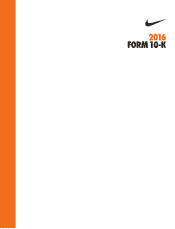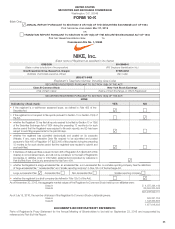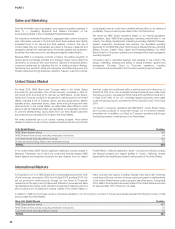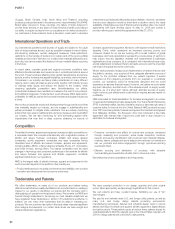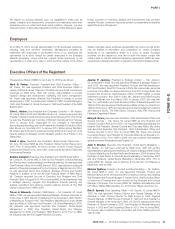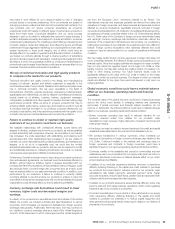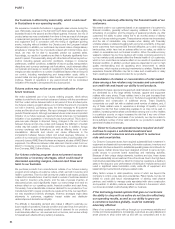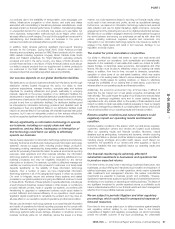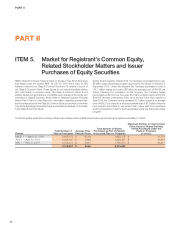Nike 2016 Annual Report Download - page 7
Download and view the complete annual report
Please find page 7 of the 2016 Nike annual report below. You can navigate through the pages in the report by either clicking on the pages listed below, or by using the keyword search tool below to find specific information within the annual report.
PART I
Uruguay, Brazil, Canada, India, South Africa and Thailand, excluding
products produced and sold in the same country. Approximately 6% of NIKE
Brand sales occurred in those countries. Any failure of Sojitz America to
provide these services or any failure of Sojitz America’s banks could disrupt
our ability to acquire products from our suppliers and to deliver products to
our customers in those markets. Such a disruption could result in canceled
orders that would adversely affect sales and profitability. However, we believe
that any such disruption would be short-term in duration due to the ready
availability of alternative sources of financing at competitive rates. Our current
agreements with Sojitz America expire on May 31, 2018 and contain a
provision allowing us to extend the agreements to May 31, 2019.
International Operations and Trade
Our international operations and sources of supply are subject to the usual
risks of doing business abroad, such as possible increases in import duties,
anti-dumping measures, quotas, safeguard measures, trade restrictions,
restrictions on the transfer of funds and, in certain parts of the world, political
instability and terrorism. We have not, to date, been materially affected by any
such risk, but cannot predict the likelihood of such material effects occurring
in the future.
In recent years, uncertain global and regional economic conditions have
affected international trade and caused a rise in protectionist actions around
the world. These trends are affecting many global manufacturing and service
sectors, and the footwear and apparel industries, as a whole, are not immune.
Companies in our industry are facing trade protectionism in many different
regions, and in nearly all cases we are working together with industry groups
to address trade issues and reduce the impact to the industry, while
observing applicable competition laws. Notwithstanding our efforts,
protectionist measures have resulted in increases in the cost of our products,
and additional measures, if implemented, could adversely affect sales and/or
profitability for NIKE as well as the imported footwear and apparel industry as
awhole.
We monitor protectionist trends and developments throughout the world that
may materially impact our industry, and we engage in administrative and
judicial processes to mitigate trade restrictions. We are actively monitoring
actions that may result in additional anti-dumping measures and could affect
our industry. We are also monitoring for and advocating against other
impediments that may limit or delay customs clearance for imports of
footwear, apparel and equipment. Moreover, with respect to trade restrictions
targeting China, which represents an important sourcing country and
consumer market for us, we are working with a broad coalition of global
businesses and trade associations representing a wide variety of sectors to
help ensure that any legislation enacted and implemented (i) addresses
legitimate and core concerns, (ii) is consistent with international trade rules,
and (iii) reflects and considers China’s domestic economy and the important
role it has in the global economic community.
Where trade protection measures are implemented, we believe that we have
the ability to develop, over a period of time, adequate alternative sources of
supply for the products obtained from our present suppliers. If events
prevented us from acquiring products from our suppliers in a particular
country, our operations could be temporarily disrupted and we could
experience an adverse financial impact. However, we believe we could abate
any such disruption, and that much of the adverse impact on supply would,
therefore, be of a short-term nature, although alternate sources of supply
might not be as cost-effective and could have an ongoing adverse impact on
profitability.
NIKE advocates for trade liberalization for footwear and apparel in a number
of regional and bilateral free trade agreements. The Trans-Pacific Partnership
(TPP), if ultimately ratified, has the potential to reduce or eliminate high rates of
customs duties for imports into the United States of NIKE products sourced
from TPP countries (primarily footwear and apparel from Vietnam and apparel
from Malaysia). Similarly, the European Union has concluded a free trade
agreement with Vietnam that, if approved, could lead to duty reduction or
elimination for footwear and apparel.
Competition
The athletic footwear, apparel and equipment industry is highly competitive on
a worldwide basis. We compete internationally with a significant number of
athletic and leisure footwear companies, athletic and leisure apparel
companies, sports equipment companies and large companies having
diversified lines of athletic and leisure footwear, apparel and equipment,
including adidas, ASICS, Li Ning, lululemon athletica, Puma, V.F. Corporation
and Under Armour, among others. The intense competition and the rapid
changes in technology and consumer preferences in the markets for athletic
and leisure footwear and apparel and athletic equipment, constitute
significant risk factors in our operations.
NIKE is the largest seller of athletic footwear, apparel and equipment in the
world. Important aspects of competition in this industry are:
•Product attributes such as quality; performance and reliability; new product
innovation and development and consumer price/value.
•Consumer connection and affinity for brands and products, developed
through marketing and promotion; social media interaction; customer
support and service; identification with prominent and influential athletes,
coaches, teams, colleges and sports leagues who endorse our brands and
use our products and active engagement through sponsored sporting
events and clinics.
•Effective sourcing and distribution of products, with attractive
merchandising and presentation at retail, both in-store and online.
We believe that we are competitive in all of these areas.
Trademarks and Patents
We utilize trademarks on nearly all of our products and believe having
distinctive marks that are readily identifiable is an important factor in creating a
market for our goods, in identifying our brands and the Company and in
distinguishing our goods from the goods of others. We consider our NIKE and
Swoosh Design trademarks to be among our most valuable assets and we
have registered these trademarks in almost 170 jurisdictions worldwide. In
addition, we own many other trademarks that we utilize in marketing our
products. We own common law rights in the trade dress of several significant
shoe designs and elements. For certain trade dress, we have sought and
obtained trademark registrations.
We have copyright protection in our design, graphics and other original
works. When appropriate, we have sought registrations for this content.
We own patents and have a patent license, facilitating our use of “Air”
technologies.
We also file and maintain many U.S. and foreign utility patents, as well as
many U.S. and foreign design patents protecting components,
manufacturing techniques, features and industrial design used in various
athletic and leisure footwear and apparel, athletic equipment, digital devices
and golf products. These patents expire at various times; patents issued for
original applications filed this calendar year in the United States may last until
2031 for design patents and until 2036 for utility patents.
60

